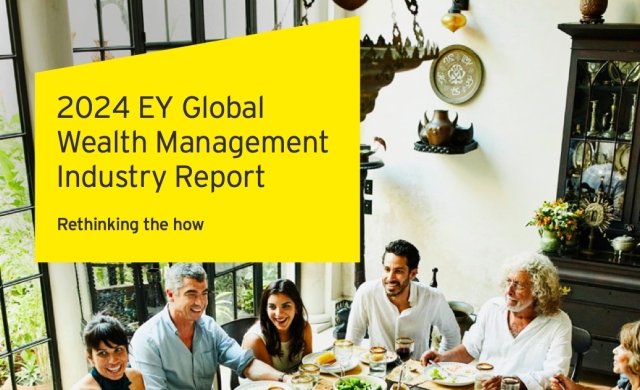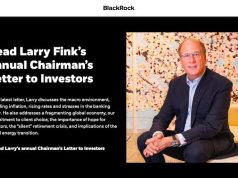EY Global Wealth Management Industry Report 2024: Global Client Wealth $320 Trillion, Hong Kong HNW Requirement $3 Million & UHNW $30 Million, Switzerland HNW Requirement $8 Million & UHNW $50 Million, United States HNW Requirement $5 Million & UHNW $50 Million, 3 Financial Pressures on Firms are Less Promising Economic Outlook, Wealth Net New Asset Growth & Investment Management Margins Squeezed
26th April 2024 | Hong Kong
EY has released the Global Wealth Management Industry Report 2024, providing key insights into the global wealth management industry, and affluent, HNW & UHNW business segment (High net worth, Ultra high net worth). The Global Private Client Wealth is currently at $320 trillion to $360 trillion (2021). The Hong Kong HNW requirement – HNW $3 million, UHNW $30 million. The Switzerland HNW requirement – HNW $8 million, UHNW $50 million. The United States HNW requirement – HNW $5 million, UHNW $50 million. Uncertainty & Ambiguity for Clients – Living through unprecedented times, Experiencing exceptional level of change, Rapid changes in next 5 years for Wealth advice, investment management and client experiences. 8 Key Trends – Slowing growth in global wealth, Demographic shifts (Longevity & Vast wealth transfers), Geopolitical strife, Regulation in multiple markets, New technologies, Growing client choice, Employment expectations & patterns of work. 3 Financial Pressures on Firms – Less promising economic outlook, Weak net new asset growth, Investment management margins squeezed. Investment Management Margins Squeezed – Growing competition, Price sensitivity, Eroding fee levels, Market consolidation. 4 Distinct Business Models – Mass affluent, Core affluent, High Net Worth, Ultra-HNW. See below for key findings & summary | View report here
“ EY Global Wealth Management Industry Report 2024: Global Client Wealth $320 Trillion, Hong Kong HNW Requirement $3 Million & UHNW $30 Million, Switzerland HNW Requirement $8 Million & UHNW $50 Million, United States HNW Requirement $5 Million & UHNW $50 Million, 3 Financial Pressures on Firms are Less Promising Economic Outlook, Wealth Net New Asset Growth & Investment Management Margins Squeezed “
EY Global Wealth Management Industry Report 2024: Global Client Wealth $320 Trillion, Hong Kong HNW Requirement $3 Million & UHNW $30 Million, Switzerland HNW Requirement $8 Million & UHNW $50 Million, United States HNW Requirement $5 Million & UHNW $50 Million, 3 Financial Pressures on Firms are Less Promising Economic Outlook, Wealth Net New Asset Growth & Investment Management Margins Squeezed

EY has released the EY Global Wealth Management Industry Report 2024, providing key insights into the global wealth management industry, and affluent, HNW & UHNW business segment. See below for key findings & summary | View report here
Summary:
- Global Private Client Wealth – Currently at $320 trillion to $360 trillion (2021)
- Hong Kong HNW requirement – HNW $3 million, UHNW $30 million
- Switzerland HNW requirement – HNW $8 million, UHNW $50 million
- United States HNW requirement – HNW $5 million, UHNW $50 million
- Lower HNW Definition – Financial independence / asset returns sustainably cover household expenses
- Upper HNW Definition – Independently wealthy / need to structure wealth
- UHNW Definition – Complex wealth management needs (family office, wealth structuring)
- Uncertainty & Ambiguity for Clients – Living through unprecedented times, Experiencing exceptional level of change, Rapid changes in next 5 years for Wealth advice, investment management and client experiences
- 8 Key Trends – Slowing growth in global wealth, Demographic shifts (Longevity & Vast wealth transfers), Geopolitical strife, Regulation in multiple markets, New technologies, Growing client choice, Employment expectations & patterns of work
- Financial Pressures on Firms – Less promising economic outlook, Weak net new asset growth, Investment management margins squeezed
- Investment Management Margins Squeezed – Growing competition, Price sensitivity, Eroding fee levels, Market consolidation
- Wealth Management Structural Changes – 1) Attractive, relatively stable margins, limited costs of capital results in more players, 2) More competition (Banks, asset managers, pension providers, health insurers and other challengers), 3) Fragmenting provider landscape, 4) Incumbents to face increasing competition
- Incumbents to face increasing competition – 1) Online brokers & WealthTech firms, 2) Asset managers, 3) Universal banks, wire houses, custody banks, health insurers and other global financial institutions
- Areas of growing investment by incumbents – 1) Improving wealth advice and planning capabilities, 2) Digitizing processes, 3) Acquiring niche investment providers, 4) Partnering with technology vendors & banking service providers
- 10 Most Important Challenges for Wealth Managers – Stand out in the age of personalization, Elevate relationship management, Deliver client-centric advice at scale, Create synergies with modular offerings, Provide seamless, consistent experiences, Redefine the relationship manager, Outperform on organic growth, Overcome complexity in operations, Build future-proof technology and data infrastructure, Redesign key control functions
- 4 Distinct Business Models – Mass affluent, Core affluent, High Net Worth, Ultra-HNW
- 6 Key Concepts to Outperform in Wealth Management (Now) – Systematic client-centric sales, Intergenerational wealth transition, Best practices for business originating units, NextGen CRM, Front office unburdening & simplification, Hybrid omni-channel client experience
EY Global Wealth Management Industry Report 2024
1) Net Wealth Threshold
Hong Kong:
- Mass affluent – $100,000
- Core affluent – $1 million
- Lower HNW – $3 million
- Upper HNW – $10 million
- UHNW – $30 million
Switzerland:
- Mass affluent – $250,000
- Core affluent – $2 million
- Lower HNW – $8 million
- Upper HNW – $25 million
- UHNW – $50 million
United States:
- Mass affluent – $150,000
- Core affluent – $1.5 million
- Lower HNW – $5 million
- Upper HNW – $15 million
- UHNW – $50 million
Definitions:
- Retail – No material longer-term financial savings / wealth accumulation
- Mass affluent – Steady accumulation of >10% pre-tax income in long-term savings / investments
- Core affluent – High income tier (top 10%) / liquidity event originated household wealth
- Lower HNW – Financial independence / asset returns sustainably cover household expenses
- Upper HNW – Independently wealthy / need to structure wealth
- UHNW – Complex wealth management needs (family office, wealth structuring)
2) Uncertainty & Ambiguity for Clients
- Every generation believes that it is living through unprecedented times.
- Wealth managers and their clients do seem to be experiencing an exceptional level of change.
- Wealth advice, investment management and client experiences are likely to change more rapidly in the next five years than in the last 20 years — creating both threats and opportunities for incumbent wealth managers.
8 Key Trends:
- Slowing growth in global wealth
- Demographic shifts, increasing longevity and vast wealth transfers between generations.
- Client preferences shifting toward greater personalization, convenience, sustainability and risk aversion.
- Geopolitical strife including direct conflict, multipolar rivalry, social tensions, climate change and new diseases
- Advance of regulation in multiple markets, covering areas including consumer protection, financial stability, privacy, data protection, climate and sustainability.
- Disruption and displacement from new technologies such as Generative AI (GenAI), emerging technologies like blockchain and quantum computing, and
cyber threats such as ransomware. - Growing client choice, with investment innovations ranging from the democratization of private markets to the growth of digital currencies and the emergence of tokenized assets.
- Changing employment expectations and patterns of work affecting both clients and wealth management staff across areas as diverse as purpose, work-life balance, career progression and remote working.
3) Why Change
- Clients are gaining relative power, with an increasing focus on performance, net value, experience and brand reputation.
- Digitization is transforming relationships in every wealth band, including a growing preference for self-direction among affluent clients.
- Crucial to appreciate that clients’ desire for a valuable, trusting relationship with their wealth manager remains in essence unchanged (Key moments such as market shocks or major life events when emotional stakes are in play alongside financial ones).
4) Financial Pressures on Firms
- Global private client wealth – Currently at $320 trillion to $360 trillion (2021)
- Since 2022, increases in inflation, interest rates and market volatility have created a far less promising economic outlook
- Wealth managers are experiencing weak net new asset growth
- Investment management margins squeezed
5) Investment Management Margins Squeezed
- Growing competition: Competition from new entrants is increasing (see Structural changes, below) and a growing range of investment product and service providers is accelerating the commoditization of portfolio management.
- Price sensitivity: Clients are becoming more conscious of value and, thanks to greater transparency, increasingly discerning about investment charges. Regulation is boosting fee accountability, further trimming industry margins.
- Asset allocation (Eroding fee levels): Open architecture and passive investing are eroding fee levels. Greater use of discretionary mandates and structured products has only partially offset this trend, and even higher allocations to alternative assets are unlikely to boost overall margins.
- Higher concentration / consolidation: Wealth management has experienced a surge in M&A activity since the COVID-19 pandemic, albeit with variations across regions. The resulting consolidation of market share is accelerating competitive dynamics.
EY: There is every indication that wealth managers will face an incremental further erosion in gross margins over the rest of the decade. Profitability pressures are being reinforced by rigid cost structures, increasing operational complexity, growing compliance burdens, and fiercer competition for talent.
6) Wealth Management Structural Changes
- Wealth management historically attractive and relatively stable margins, together with its risk profile and limited costs of capital (more players)
- Banks, asset managers, pension providers, health insurers and other challengers to establish or extend their market presence.
- This is fragmenting the provider landscape
- Expect incumbents to face increasing competition
7) Expect incumbents to face increasing competition
- Online brokers &WealthTech firms. So far, this group has had a limited impact on revenue and profit pools, but their influence will grow, especially as younger generations inherit and build greater wealth and WealthTech firms accelerate the digitization of the industry.
- Asset managers, some of which will respond to acute growth and profitability pressures in their core activities by seeking to push further into wealth management with differentiated value propositions.
- Universal banks, wire houses, custody banks, health insurers and other global financial institutions, are doubling down on their efforts to extend their footprint among both affluent and high net worth (HNW) clients.
Increasing competition from these maturing players will accelerate structural change in wealth management, forcing incumbents to defend their market positions, enhance their capabilities, differentiate themselves more strongly and rethink the synergies offered by parent groups’ integrated business models
Areas of growing investment by incumbents include:
- Improving wealth advice and planning capabilities; almost half of financial advisors planned to make upgrades to front office platforms in 2023 to improve client journeys.
- Digitizing processes such as client onboarding including KYC and AML, portfolio management, client reporting, middle office operations, regulatory compliance
and marketing. - Acquiring niche investment providers, such as alternative asset managers.
- Partnering with technology vendors & banking service providers to reduce time-to-market and overcome the limitations of legacy technology systems.
8) 10 Most Important Challenges for Wealth Managers (Create value for clients, stakeholders & society)
- Stand out in the age of personalization
- Elevate relationship management
- Deliver client-centric advice at scale
- Create synergies with modular offerings
- Provide seamless, consistent experiences
- Redefine the relationship manager
- Outperform on organic growth
- Overcome complexity in operations
- Build future-proof technology and data infrastructure
- Redesign key control functions
9) 20 Key Concepts to Execute
- Advice-centered affluent banking
- Advisor co-pilot
- Best practices for business originating units
- Client-centric wealth advice
- Client intelligence & data foundation
- Complexity reduction and efficiency improvement in core operations
- Enhanced CRM
- Extended incentive models for front office
- Front office unburdening & simplification
- Future-proof core operations architecture
- Harnessing AI for wealth management
- Hybrid omni-channel client experience
- Intergenerational wealth transition
- Personalized talent development for relationship managers
- Personalized insights for clients at scale
- Strategic leverage of alternative investment products
- Structural redesign of compliance
- Sustainable investing and client investment experience
- Systematic client-centric sales
- Virtual engine for financial and wealth advice
10) Elevating the Value of Advice
4 distinct business models:
- Mass affluent
- Core affluent
- High Net Worth
- Ultra-HNW
Mass affluent: Advice focuses on building and maintaining financial health. Financial planning
is the relationship anchor. Advisors act as coaches who empower clients to navigate their decisions, harness a modular offering, and achieve their financial goals. Delivering this client-centric model at scale is the greatest challenge for firms (for more details see section 3.1).
Core affluent: Similar to the mass affluent model, but with more wealth advisory mentoring. Holistic financial planning is focused on wealth aggregation with long-term goals forming the core of the advisory relationship. Again, scaling is a key challenge.
High Net Worth: Advice focuses on protecting and growing long-term wealth. Wealth planning involving family members forms the relationship anchor. Advisors should act as trusted fiduciaries service clients’ best interests and providing unbiased advice. Value propositions vary with client need (e.g., entrepreneurs, executives, independent wealthy) and lifecycle stage. A robust self-service platform for self-directed clients is a key feature and can also effectively act as a feeder.
Ultra-HNW: Advice focuses on adding value through complex multidisciplinary subject matter expertise in cooperation with an extended ecosystem — such as advising clients on personal legacies, foundations or trust arrangements. The advisor acts as a trusted professional, combining strategic thinking, analytic skills, and clear communications with the ability to orchestrate multiple actors and solutions. Managing costs to serve is a key challenge.
11) Key Concepts to Outperform in Wealth Management
Now (Current)
- Systematic client-centric sales
- Intergenerational wealth transition
- Best practices for business originating units
- NextGen CRM
- Front office unburdening and simplification
- Hybrid omni-channel client experience
Next
- Client-centric wealth advice
- Personalized talent development for relationship managers
- Personalized insights for clients at scale
- Sustainable Investing and client investment experience
- Extended incentive models for front office
- Strategic leverage of alternative investment products
- Harnessing AI for wealth management
- Client intelligence and data foundation
Beyond
- Advisor co-pilot
- Virtual financial and wealth advisory engine
- Advice-centered affluent banking
- Structural redesign of compliance
- Future-proof core operations architecture
- Complexity reduction and efficiency improvement in core operations
12) In-depth Insights
Benefits of advice-centric affluent banking models include:
- More effective cross-selling, as clients implement better financial decisions quickly and easily within a central ecosystem.
- Increasing market share and business volumes as more clients’ financial health improves, and self-reinforcing effects accelerate enhancements of perceived value.
- Greater client lifetime value as retention improves, with clients staying through the accumulation and decumulation phases.
- More stable revenue and profit, as greater customer scale enhances predictability, strategic planning and resilience to market volatility.
Benefits of client-centric wealth advice and services include:
- Stronger long-term client profitability and better overall financial performance than for firms with more generic advice models.
- Enhanced customer loyalty and greater likelihood of clients consolidating their assets with their lead wealth provider.
- Higher yearly numbers of new clients per relationship manager, together with stronger recurring revenue streams and better value extraction.
- Materially improved positioning to address the key challenge of intergenerational wealth transfer.
Benefits of a defined business and operating model for intergenerational wealth transition include:
- Increased capture of intergenerational wealth during donor lifetimes, building the foundation for additional asset growth with inheritors.
- Higher trust, perceived net value and wallet share among donor clients and their partners.
- The acquisition of clients inheriting wealth from donors who were competitors’ clients, with the potential for high levels of client development and retention.
Benefits of harnessing AI for wealth and asset management include:
- The transformation of client interactions and communications using AI, especially for self-service clients, cross interaction channels and in real time.
- Enhanced client experiences owing to more valuable, tailored recommendations for products and services.
- Significant efficiency gains achieved through task automation and process simplification.
About EY
EY exists to build a better working world, helping to create long-term value for clients, people and society and build trust in the capital markets. Enabled by data and technology, diverse EY teams in over 150 countries provide trust through assurance and help clients grow, transform and operate. Working across assurance, consulting, law, strategy, tax and transactions, EY teams ask better questions to find new answers for the complex issues facing our world today.
Sign Up / Register
Caproasia Users
- Manage $20 million to $3 billion of assets
- Invest $3 million to $300 million
- Advise institutions, billionaires, UHNWs & HNWs
Caproasia Platforms | 11,000 Investors & Advisors
- Caproasia.com
- Caproasia Access
- Caproasia Events
- The Financial Centre | Find Services
- Membership
- Family Office Circle
- Professional Investor Circle
- Investor Relations Network
Monthly Roundtable & Networking
Family Office Programs
The 2025 Investment Day
- March - Hong Kong
- March - Singapore
- July - Hong Kong
- July - Singapore
- Sept- Hong Kong
- Sept - Singapore
- Oct- Hong Kong
- Nov - Singapore
- Visit: The Investment Day | Register: Click here
Caproasia Summits
- The Institutional Investor Summit
- The Investment / Alternatives Summit
- The Private Wealth Summit
- The Family Office Summit
- The CEO & Entrepreneur Summit
- The Capital Markets Summit
- The ESG / Sustainable Investment Summit

































